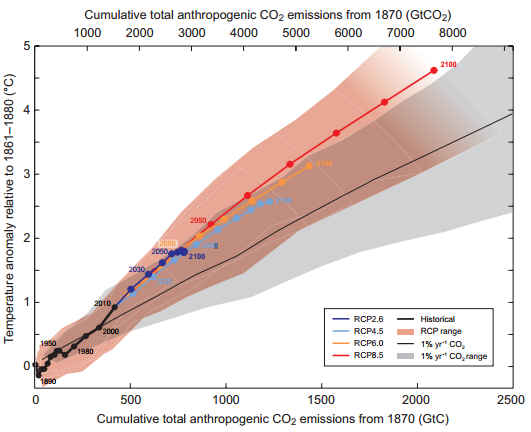Since the beginning of the industrial era, we have been burning coal and petrol to produce energy. As well as energy, this produces « greenhouse gases », mostly CO2, which accumulate slowly in the atmosphere. It acts like a blanket, and the earth's atmosphere slowly heats up.
Global warming has many consequences : higher temperatures, changes in rain patterns, more unstable weather, glaciers melting, sea-level rises, oceans becoming more acid…
The more greenhouse gases we release into the atmosphere, the higher the average temperature will be. This is summarised in the following graph from the IPCC report (Intergovernmental Panel on Climate Change):

It takes a while to understand this graph… On the horizontal axis, it shows the quantity of greenhouse gases released into the atmosphere, and on the vertical axis it gives the probable increase in temperature corresponding to this quantity of greenhouse gases.
The coloured lines represent the evolution of the quantities of gas in the atmosphere according to different political scenarios, from a rapid decrease in emissions (RCP2,6) to emissions that remain high (RCP8.5). In the current political stalemate, without a radical action to reduce greenhouse gases, we will follow the red line, with global warming approaching 5 degrees by 2100. With rapid and efficient political action, we could follow the dark blue line, and limit global warming to 2°C.
To use the graph, you choose the acceptable warming (two degrees for example), and read the quantity of greenhouse gases that we can still release into the atmosphere… But the problem is of course not solved, because politicians argue about who has the right to emit most - to share out the remaining CO2 quotas between countries…
May 2015 : the level of CO2 in the atmosphere has reached 400 ppm. The last time the level of CO2 was this high was the Pliocene, 5 million years ago. The average temperature was 2-3°C warmer, and the sea level was 25 meters higher. The view of Nasa scientists... Current levels...
Video on the first report:
What is global warming?





